|
Become a Pilot! |
|
Share this page on:

|
|
Why learn to fly?
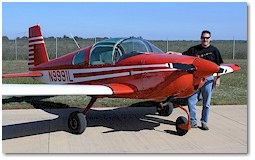 The best thing about being a part of the aviation community is that you only need to have one thing in common
with your fellow aviation enthusiasts; a passion for flight. You don’t need to fit a certain mold to become
a pilot or enjoy flying. Aviation brings people together from all walks of life because anyone can fly.
The best thing about being a part of the aviation community is that you only need to have one thing in common
with your fellow aviation enthusiasts; a passion for flight. You don’t need to fit a certain mold to become
a pilot or enjoy flying. Aviation brings people together from all walks of life because anyone can fly.
Even though it’s a small, rather tight-knit community, it isn’t difficult to be accepted into this faction
of flight fanatics. Want to be a pilot? You’re in! Love airplanes? You’re in! Love to fly, or even the
idea of flight? You’re in!
|
What is a pilot certificate?
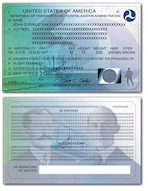 An FAA-issued pilot certificate is, literally, your license to fly. It proves that you are authorized to exercise the piloting privileges for which you have been certified.
An FAA-issued pilot certificate is, literally, your license to fly. It proves that you are authorized to exercise the piloting privileges for which you have been certified.
The general structure of FAA pilot certification is student pilot, sport pilot, recreational pilot, private pilot, commercial pilot, and airline transport pilot (ATP).
As a beginner, you will need to obtain a student pilot certificate, as this is the certificate that will allow you to learn to fly, and a medical certificate, depending on the type of certificate you are working toward.
A student pilot certificate is not necessary to begin flight training, but you will need it to be able to fly solo. As a student pilot, you will train for one of the following: sport pilot, recreational pilot, or private pilot. The most common certificates issued are sport pilot and private pilot.
A pilot certificate never expires, however every pilot is subject to a flight review with a certified flight instructor (CFI) every two years from the month in which they were certificated. The flight instructor will endorse your logbook to prove the review was successfully completed.
|
What is a Student Pilot Certificate?
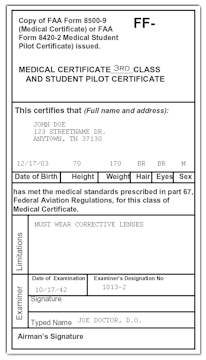 One of the first steps toward earning your wings, is earning your student pilot certificate.
One of the first steps toward earning your wings, is earning your student pilot certificate.
Students working toward a private pilot certificate will need to undergo a routine medical examination administered by an FAA-designated doctor called an aviation medical examiner (AME). If the appropriate medical standards are met, the AME will issue you a student pilot certificate.
Students working toward a sport pilot certificate can receive a student pilot certificate from a Standards District Office (FSDO) or FAA-designated pilot examiner simply by showing a valid U.S. driver’s license.
A student pilot certificate is not necessary to begin flight training.
The student pilot certificate is valid as long as the third-class medical certificate; until the last day of the month, two to five years from the month it was issued. For a private pilot certificate it is valid for two years if you are over 40 years old, and five years if you are under 40. For a sport pilot certificate, it is valid for five years.
Once a student has accrued sufficient training and experience, a CFI can endorse the student's certificate to authorize limited solo flight in a specific type (make and model) of aircraft. A student pilot may not carry passengers, fly in furtherance of a business, or operate an aircraft outside of the various endorsements provided by the flight instructor.
You MUST obtain a student pilot certificate before you are allowed to fly solo.
|
What is a Private Pilot Certificate?
 The private pilot certificate is held by the majority of active pilots as it has the fewest limitations. It allows a pilot to fly any aircraft (subject to appropriate ratings) with passengers for any non-commercial purpose, day or night, and gives almost unlimited authority to fly under visual flight rules (VFR). The private pilot certificate is recognized internationally and allows a pilot to fly almost anywhere in the world with the proper authorization.
The private pilot certificate is held by the majority of active pilots as it has the fewest limitations. It allows a pilot to fly any aircraft (subject to appropriate ratings) with passengers for any non-commercial purpose, day or night, and gives almost unlimited authority to fly under visual flight rules (VFR). The private pilot certificate is recognized internationally and allows a pilot to fly almost anywhere in the world with the proper authorization.
Private pilots may not be compensated in any way for services as a pilot, although passengers can pay a pro rata share of flight expenses, such as fuel or rental costs. A private pilot may fly for compensation or hire in connection with any business or employment as long as the flight is only incidental to that business or employment and the aircraft does not carry passengers or property for compensation or hire. (EAA)
Private pilots may also operate charity flights, subject to certain restrictions, and may participate in similar activities.
With additional training, private pilots can be authorized to fly with more advanced capabilities. An instrument rating can be added to a private certificate which allows the pilot to fly in clouds or bad weather, referencing instruments only to fly. Pilots can also be authorized to fly aircraft with two or more engines, and/or fly professionally.
As with all pilot certificates, a private pilot must do a flight review with a certified flight instructor (CFI) every two years from the month in which they were certificated to make sure no bad habits have emerged in one's flying skills. A flight review may consist of as little as one hour of ground school and one hour of flight time. The CFI will endorse your logbook to prove the review was successfully completed.
Private pilots must also renew their medical certificate every two to five years depending on their age.
|
What is a Sport Pilot Certificate?
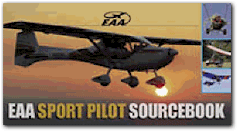 Thanks to efforts put forth by the EAA, in 2004 the FAA created the sport pilot/light-sport aircraft (SP/LSA) regulations. SP/LSA allows easier and lower-cost access for those who want to participate in the joys of flight.
Thanks to efforts put forth by the EAA, in 2004 the FAA created the sport pilot/light-sport aircraft (SP/LSA) regulations. SP/LSA allows easier and lower-cost access for those who want to participate in the joys of flight.
The sport pilot certificate can be earned in as little as 20 hours and allows you to fly only light-sport aircraft; one- or two-seat aircraft capable of speeds up to 138 mph. SP/LSA regulations gives authorization to fly during the daytime under limited visual flight rules (VFR), in the U.S. only. In most cases, you can pass the medical requirements simply by having a valid U.S. driver’s license.
A sport pilot must do a flight review with a certified flight instructor (CFI) every two years from the month in which they were certificated to make sure no bad habits have emerged in one's flying skills. A flight review may consist of as little as one hour of ground school and one hour of flight time. The CFI will endorse your logbook to prove the review was successfully completed.
Click here to learn more about sport pilot/light-sport aircraft.
Click here to download the EAA Sport Pilot Sourcebook.
|
How much time does it take?
How long it takes you to learn to fly is up to you. Most students need more training time than
the required minimum to be prepared and comfortable enough to pass their final test, the checkride.
Below is a brief overview of the minimum hours of flight time required for a private
and sport pilot certificate and the minimum age for training and certification.
Training hours include dual instruction (instructor and student), cross-country
flying (departing one airport and landing at another), and solo flight.
|
|
Min. Age to Begin Training
|
Min. Age for Certification
|
Min. Training Times
|
|
Sport Pilot
|
|
|
Solo
|
Dual
|
Total
|
|
Airplane
|
16
|
17
|
5
|
15
|
20
|
|
Weight-shift trike
|
16
|
16
|
5
|
15
|
20
|
|
Glider
|
14
|
17
|
2
|
8
|
10
|
|
Powered parachute
|
16
|
17
|
2
|
10
|
12
|
|
Gyro
|
16
|
17
|
5
|
15
|
20
|
|
Balloon
|
14
|
16
|
2
|
5
|
7
|
|
Airship
|
16
|
17
|
5
|
15
|
20
|
|
Private Pilot
|
|
|
Solo
|
Dual
|
Total
|
|
Airplane
|
16
|
17
|
10
|
30
|
40
|
|
Note: This chart demonstrates the minimum hours of flight required
and the minimum age at which you can start your flight training. Most student pilots
require additional flight time to pass the checkride.
|
|
As you can see, the sport pilot certificate requires half the amount of hours than a private pilot certificate.
Therefore, a sport pilot certificate can be obtained in about half the time, and about half the price, of a
private certificate.
Since most can't put forth a full-time effort into their pilot training, it's realistic to assume a sport
pilot certificate will take 1 to 2 months and a private certificate will take 3 to 4 months to obtain.
Ideally, you should try to fly at least once a week to maintain a higher level of proficiency.
If you are training for a sport pilot certificate and ever wish to upgrade to a private pilot, in most
cases, your sport pilot training can be applied toward gaining a private certificate.
|
How much does it cost?
Costs vary nationwide, so it is wise to do some research before you begin training.
Talk to your local flight schools and/or local flight instructors to find a price
and instructor that best fits your means and needs.
The chart below gives an overview of the estimated overall cost to learn to fly
for your private pilot and sport pilot certificate. The costs shown represent
an estimated average for pilot training costs. The cost of your personal pilot
training experience may be more or less than the rates shown below.
| PILOT TRAINING COST ESTIMATOR |
Private |
Sport |
|
Cost |
Hours |
| Training Materials & Supplies* |
$400 |
$300 |
| Tests & Exams* |
$600 |
$300 |
| Student Certificate* |
$40 |
$40 |
| Medical Exam* |
$125 |
n/a |
| Aircraft Rental & Flight Instruction* |
6,500 |
$2,500 |
| Total |
$7,665 |
$3,140 |
| Additional training* (if needed) |
$2,500 |
$2,000 |
| Realistic Budget |
$10,165 |
$5,140 |
| * Prices may vary between flight schools/instructors, training materials, etc. |
|
Don't let the total amount discourage you. It's best not to think of it as a
cost but rather as a life's investment. Remember that it's a once-in-a-lifetime
chance, and once you learn to fly, you can fly forever.
|
OK, I'm ready! What now?
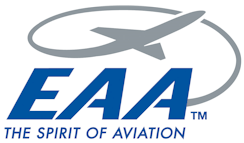 Why not consider becoming a member
of the EAA (Experimental Aircraft Association)? Then find a local EAA Chapter near you.
It's always a good idea to surround yourself with people who also love aviation and are willing to share their experiences with you.
Why not consider becoming a member
of the EAA (Experimental Aircraft Association)? Then find a local EAA Chapter near you.
It's always a good idea to surround yourself with people who also love aviation and are willing to share their experiences with you.
The EAA has provided useful
Resources for Earning Your Wings, Flight Training Resources, General Aviation Organizations, Aviation Youth Programs and
General Aviation News & Publications.
|
|
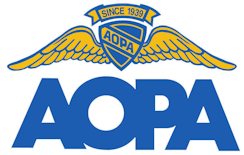 Also consider becoming a member
of the AOPA (Aircraft Owners and Pilots Association). The AOPA provides member
services that range from representation at the federal, state, and local levels to legal services, advice, and other assistance.
Also consider becoming a member
of the AOPA (Aircraft Owners and Pilots Association). The AOPA provides member
services that range from representation at the federal, state, and local levels to legal services, advice, and other assistance.
They are sponsoring
the Flight Training Initiative, which is a long-term, industry-wide effort dedicated to increasing the percentage of
students who earn a pilot certificate.
Don't wait! Do it today!
|
|
|
Resources for Earning Your Wings
|
|
Earning My Wings
|
A video blog about learning to fly.
|
|
MyFlightBlog
|
A blog about earning a private pilot certificate and experiences as a pilot.
|
|
Airfreddy’s Learn to Fly Blog
|
For people who don't know anything about flying and want to learn to fly.
|
|
Start to Fly - UK
|
Expert advice to help you learn to fly.
|
|
EAA – Sport Pilot Sourcebook
|
EAA’s guide to the sport pilot rule, how it affects you, maintenance, instruction, and much more.
|
|
EAA – Reach for the Sky
|
EAA’s guide to learning to fly and light-sport aircraft.
|
|
ASA – You Can Fly!
|
An introduction to the world of flying and flight instruction for prospective pilots.
|
|
AOPA PATH
|
Pilot and Teacher’s Handbook.
|
|
Flight Training Resources
|
|
AOPA – Flight School Directory
|
|
|
AOPA – Let’s Go Flying
|
|
|
NAFI – Find a Flight Instructor
|
|
|
Cessna Pilot Center
|
|
|
King Schools
|
The world's leading producer of aviation interactive learning software
|
|
Gleim Aviation
|
|
|
Flight Design Pilot Center
|
|
|
Aviation Schools Online
|
Your complete resource for locating, researching, and contacting schools in the aviation industry.
|
|
Flight School List
|
Largest aviation schools directory on the internet.
|
|
Sporty’s Pilot Shop
|
|
|
ASA
|
Aviation Supplies & Academics, Inc.
|
|
Become a Pilot
|
|
|
Easy Flight
|
|
|
Thirty Thousand Feet
|
An aviation directory with thousands of links to aviation web pages, news, and other sources of commercial, military, and general aviation information.
|
|
Remos
|
|
|
General Aviation Organizations
|
|
EAA
|
Experimental Aircraft Association
|
|
AOPA
|
Aircraft Owners and Pilots Association
|
|
NAFI
|
National Association of Flight Instructors
|
|
IAC
|
International Aerobatics Club
|
|
SSA
|
Soaring Society of America
|
|
The Ninety-Nines, Inc.
|
International Organization of Women Pilots
|
|
WAI
|
Women in Aviation International
|
|
USUA
|
U.S. Ultralight Association
|
|
USPPA
|
U.S. Powered Paragliding Association
|
|
PRA
|
Popular Rotorcraft Association
|
|
ESA
|
Experimental Soaring Association
|
|
USHPA
|
U.S. Hang Gliding and Paragliding Association, Inc.
|
|
NBAA
|
National Business Aviation Association
|
|
IAOPA
|
International Council of Aircraft Owner and Pilot Associations
|
|
Experimental Aircraft Association (EAA)
|
|
EAA
|
|
|
Become a Member
|
|
|
EAA Chapters
|
|
|
EAA – Learn to Fly
|
|
|
EAA – Sport Pilot
|
|
|
EAA – Aviation Calendar of Events
|
|
|
AirVenture
|
|
|
Aviation Youth Programs
|
|
EAA Young Eagles
|
A chance for young people, ages 8-17, to go flying in a general aviation aircraft free of charge.
|
|
EAA Air Academy
|
An exciting aviation summer camp for young people.
|
|
Civil Air Patrol (CAP)
|
If you’re dreaming of a career in aviation, space, or the military, CAP’s Cadet Program is for you.
|
|
Aviation Explorers
|
A youth development program centered around aviation careers.
|
|
Youth Program Directory
|
A web directory of Youth in Aviation websites.
|
|
General Aviation News & Publications
|
|
General Aviation News
|
Provides up-to-the-minute, factual details about all aspects of general aviation.
|
|
AvWeb
|
World’s premier independent aviation news resource.
|
|
Pilot Web
|
|
|
EAA Radio
|
A source of live, up-to-date information for those attending AirVenture; archives broadcasting year-round.
|
|
Aviation Today
|
Your first destination for global industry intelligence.
|
|
AvBuyer
|
The global aircraft market online.
|
|
AvStop
|
Aviation online magazine.
|
|
AOPA – Flight Training
|
|
|
Plane & Pilot
|
The magazine for active piston-engine pilots.
|
|
Pilot Getaways
|
|
|
EAA – Sport Aviation
|
|
|
Flying
|
|
|
Gliding Magazine
|
The online magazine for glider pilots world-wide.
|
|
Flight Journal
|
|
|
Aero.com
|
A listing of worldwide aviation magazines.
|
|
|
|
|
 |
HELP FOR THE HOMEBUILDER
A website designed for Van's Aircraft Homebuilders, helping them find the
information they need to build the most dynamic aircraft in the world.
|
|
|
| The "cover your butt" section |
|
This website was built to document the construction of an RV-9A in
compliance with the FAA requirements needed to certify the aircraft. Any experiences and/or comments are by
no means to be considered as instructions on how to build an RV-9A or any other aircraft. Please read our Disclosure for details.
|
|
|
This is website is owned and published by OpenAirNet, Inc. © 2015. All rights reserved.
|
|
|
|